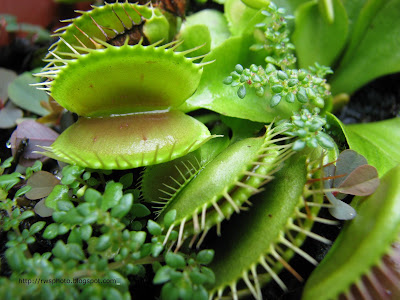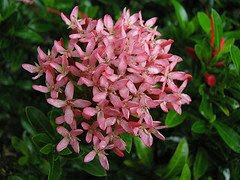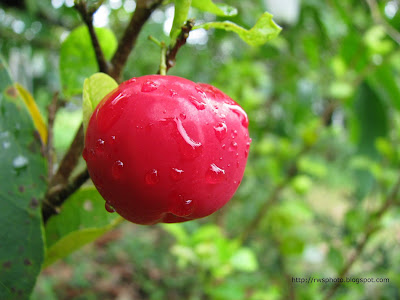The Venus Flytrap, Dionaea muscipula, is a carnivorous plant that catches and digests animal prey—mostly insects and arachnids. Its trapping structure is formed by the terminal portion of each of the plant's leaves and is triggered by tiny hairs on their inner surfaces. When an insect or spider crawling along the leaves comes into contact with one or more of the hairs twice in succession, the trap closes. The requirement of redundant triggering in this mechanism serves as a safeguard against the spurious expending of energy toward trapping other, non-living things which may not reward the plant with similar nutrition.


The Venus Flytrap is a small plant, forming a rosette of four to seven leaves, which arise from a short subterranean stem that is actually a bulb-like object. Each steam reaches a maximum size of about three to ten centimeters, depending on the time of year; longer leaves with robust traps are usually formed after flowering. Flytraps that have more than 7 leaves are colonies formed by rosettes that have divided beneath the ground.
The leaf blade is divided into two regions: a flat, heart shaped photosynthetic capable petiole, and a pair of terminal lobes hinged at the midrib, forming the trap which is the true leaf. The upper surface of these lobes contains red anthocyanin pigments and its edges secrete mucilage. The lobes exhibit rapid plant movements, snapping shut when stimulated by prey. The trapping mechanism is tripped when prey items stumble against one of the three hair-like trichomes that are found on the upper surface of each of the lobes.
The trapping mechanism is so specialized that it can distinguish between living prey and non-prey stimuli such as falling raindrops; two trigger hairs must be touched in succession or one hair touched twice, whereupon the lobes of the trap will snap shut in about 0.1 seconds. The edges of the lobes are fringed by stiff hair-like protrusions or cilia, which mesh together and prevent large prey items from escaping. (These protrusions, and the trigger hairs, are probably homologous with the tentacles found in this plant’s close relatives, the sundews.) The holes in the meshwork allow small prey to escape, presumably because the benefit that would be obtained from them would be less than the cost of digesting them. If the prey is too small and escapes, the trap will reopen within 12 hours. If the prey moves around in the trap, it tightens and digestion begins more quickly.
Speed of closing can vary depending on the amount of humidity, light, size of prey, and general growing conditions. The speed with which traps close can be used as an indicator of a plant's general health. Venus Flytraps are not as humidity dependent as are some other carnivorous plants, such as Nepenthes, Cephalotus, most Heliamphora, and some Drosera.
Photo location: Jln Stakan, Kuching













